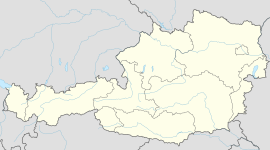world.wikisort.org - Austria
Hainburg an der Donau is a town in the Bruck an der Leitha district, Lower Austria, Austria.
Hainburg an der Donau | |
|---|---|
 Hainburg an der Donau | |
 Hainburg an der Donau Location within Austria | |
| Coordinates: 48°8′45″N 16°56′46″E | |
| Country | Austria |
| State | Lower Austria |
| District | Bruck an der Leitha |
| Government | |
| • Mayor | Helmut Schmid (ÖVP) |
| Area | |
| • Total | 24.98 km2 (9.64 sq mi) |
| Elevation | 161 m (528 ft) |
| Population (2018-01-01)[2] | |
| • Total | 6,570 |
| • Density | 260/km2 (680/sq mi) |
| Time zone | UTC+1 (CET) |
| • Summer (DST) | UTC+2 (CEST) |
| Postal code | 2410 |
| Area code | 02165 |
| Website | www.hainburg.at |
Geography
Hainburg is located on the right bank of the Danube river, 4 km southwest of Devín (Slovakia), 12 km west of the Slovak capital Bratislava and 43 km east of the Austrian capital Vienna. It is part of the Industrial Quarter Industrieviertel in Lower Austria.
45.87% of the land is forested, 54.13% is used for agriculture and urban areas.
Population
| Year | Pop. | ±% |
|---|---|---|
| 1971 | 6,060 | — |
| 1981 | 5,731 | −5.4% |
| 1991 | 5,753 | +0.4% |
| 2001 | 5,651 | −1.8% |
| 2006 | 5,717 | +1.2% |
| 2011 | 5,951 | +4.1% |
| 2021 | 6,975 | +17.2% |
History


- The first settlers in the area were the Illyrians and the Celtic people, who lived on the Braunsberg hill.
- Roman era: The area was under the influence of the nearby town of Carnuntum, the capital of the province of Pannonia Superior, where Marcus Aurelius once resided.
- 1050: Emperor Henry III ordered a castle built here.
- 13th century: The town had 2 gates, 15 towers, and a 2.5 km wall.
- 1108: The castle belonged to the Babenbergers.
- Around 1220 to 1225: The ransom received from Richard the Lionheart built the castle and the Viennese gate.
- 11 February 1252: Ottokar II, later the King of Bohemia, married the last Babenberger Margaret of Austria.
- 1267 to 1268: Ottokar II of Bohemia built the lower part of the castle.
- 1278: In the Battle of Dürnkrut, Ottokar II lost the castle to the Habsburgs.
- 1482: Siege of Hainburg: after several months siege the castle was occupied by Hungarian King Matthias Corvinus and his Black Army.
- 1629: The castle belonged to the city.
- 11 July 1683: The Second Ottoman Campaign destroyed the city and the castle.
- 1709: Count Löwenberg rebuilt the castle.
- 1738: Joseph Haydn the composer came to Hainburg as a six-year-old child to learn the rudiments of music from his relative Josef Mathias Franck. He sang as a choirboy. There is a Haydn Fountain on the Hauptplatz in the town.
- 19th century: Hainburg gained a garrison.
- End of the First World War: From now Hainburg was the easternmost town in Austria.
- 1984: Occupation of the Hainburger Au: Protesters against plans to put a power station in the Hainburger Au of the Danube forced the government of Austria to withdraw.

- Today: Hainburg is part of the Danube-Auen National Park.
Sites of interest
- Castle hill
- Danube-Auen National Park, floodplain forest
- Braunsberg, hill with Celtic fortress
- Wienertor (Vienna Gate): built in the 13th century, largest still existing medieval gate in Europe. Today it contains the city museum.
- The Philippus-und-Jakobus-Kirche, a catholic church, was built in 1263 and rebuilt in the Baroque style in 1683
- Protestant Church, opened in April 2011, newly built by the Austrian architect group Coop Himmelb(l)au
Economics and infrastructure
In 2001, there were 242 businesses and 29 agricultural and forestry businesses. There were 2,512 employed persons. The productivity rate was 45.07%. There were 70 unemployed persons.
References
- "Dauersiedlungsraum der Gemeinden Politischen Bezirke und Bundesländer - Gebietsstand 1.1.2018". Statistics Austria. Retrieved 10 March 2019.
- "Einwohnerzahl 1.1.2018 nach Gemeinden mit Status, Gebietsstand 1.1.2018". Statistics Austria. Retrieved 9 March 2019.
External links
| Wikimedia Commons has media related to Hainburg an der Donau. |
- Official site of the village Hainburg (German)
- 'Donauauen' (English/German)
- 'Wienertor' (German)
- "20 years of Occupation of Hainburger Au" (German)
На других языках
- [en] Hainburg an der Donau
[ru] Хайнбург-ан-дер-Донау
Хайнбург-ан-дер-Донау (нем. Hainburg an der Donau) — город в Австрии, в федеральной земле Нижняя Австрия.Текст в блоке "Читать" взят с сайта "Википедия" и доступен по лицензии Creative Commons Attribution-ShareAlike; в отдельных случаях могут действовать дополнительные условия.
Другой контент может иметь иную лицензию. Перед использованием материалов сайта WikiSort.org внимательно изучите правила лицензирования конкретных элементов наполнения сайта.
Другой контент может иметь иную лицензию. Перед использованием материалов сайта WikiSort.org внимательно изучите правила лицензирования конкретных элементов наполнения сайта.
2019-2025
WikiSort.org - проект по пересортировке и дополнению контента Википедии
WikiSort.org - проект по пересортировке и дополнению контента Википедии
